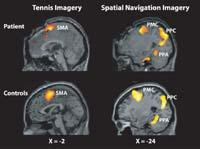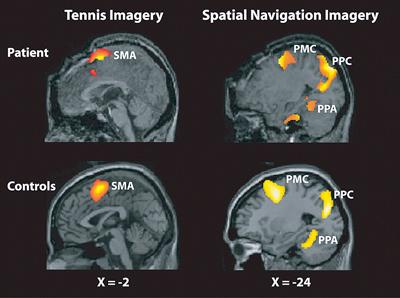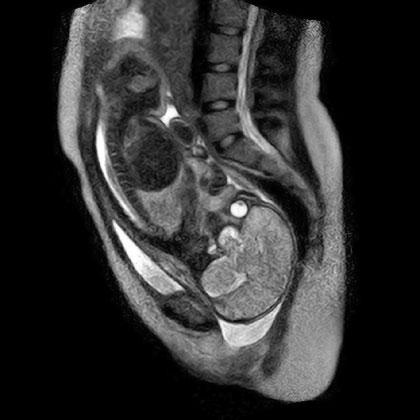Seeking the limit of consciousness
2010/02/22 Galarraga Aiestaran, Ana - Elhuyar Zientzia
Since the late 1980s, several neurosciences have proposed tests to differentiate patients in deep coma from those partially conscious. They were mainly based on the ability to respond to stimuli.
In 2006 the Owen team took another step. A 26-year-old woman, who was in a coma after a car accident, decided to continue her brain activity with a functional MRI representation. After several months of research, they received a surprising result. And they asked him to imagine two situations: one in which he had to imagine that he was playing tennis, and another in which he was at home, on his way to his room. The images collected by scanner were completely different in one and the other.

Owen's scanner images of a seemingly unconscious woman (2006). The brain activity was different, asking the woman to imagine playing tennis (left) or in a house (right).
(Photo: Olwen et al./Science)
This work was published in the scientific journal Science and sparked debate on the definition of being conscious. Some people think that it is not enough to show that the brain has a certain activity, but that it should be seen that this activity is the fruit of oneself and not unconscious.
In this case, the researchers did not hesitate. In fact, they only gave the order of representation verbally once and the neuronal network corresponding to this activity was active for about 30 seconds. However, when activation is unintentional, it only lasts a few seconds.
Owen and his team have continued to work and have published their findings and conclusions in the prestigious medical journal New England Journal of Medicine. The work has had a great impact on specialized mediums in medicine and science in general, which have shown that the brain scanner is useful to know the degree of consciousness of those in coma.
During the study, the activity of 54 patients with functional representation by magnetic resonance imaging was analyzed. And they discover that four diagnosed patients were vegetative and were able to imagine themselves playing tennis or at home.
Able to communicate
One of them had been in vegetative condition for five years with diagnosis. He was 22 years old and was also in this situation as a result of a car accident. Well, the researchers decided to do a deeper research with her. They wanted to see if he was able to communicate.
Since through a scanner it is not possible to distinguish whether someone is thinking about himself or not, they did ask him to imagine that he was playing tennis when he wanted to answer, and to tell him otherwise, that he was at home. Then they asked him simple questions, like "Is his father's name Alexander? ". And of six questions answered correctly five, leaving the sixth unanswered.
Therefore, functional MRI representation can be useful not only to diagnose the consciousness of those in coma, but also to communicate. However, communication is limited. Researchers have recognized that even in those cases where minimal communication can be achieved, they do not know whether they can go further and whether the method can serve to clarify a common concern between the family member and hospital staff. That is, if the person in this situation wants to stay alive.
Published in Gara

Gai honi buruzko eduki gehiago
Elhuyarrek garatutako teknologia





